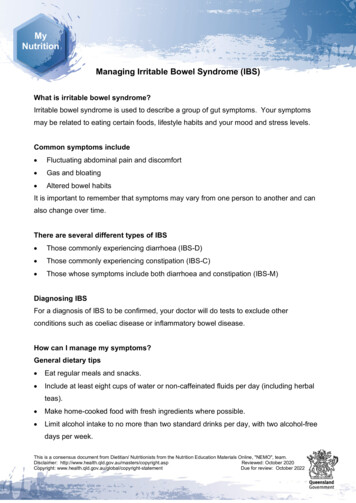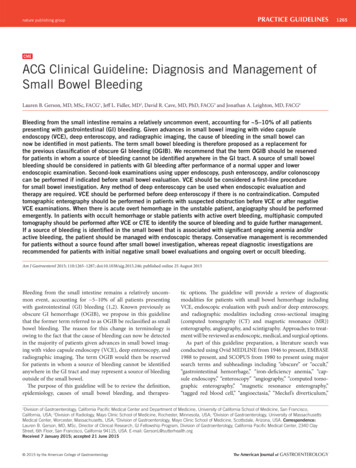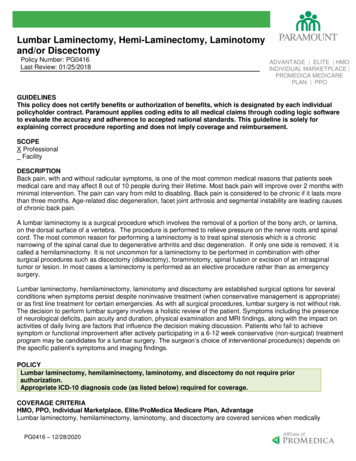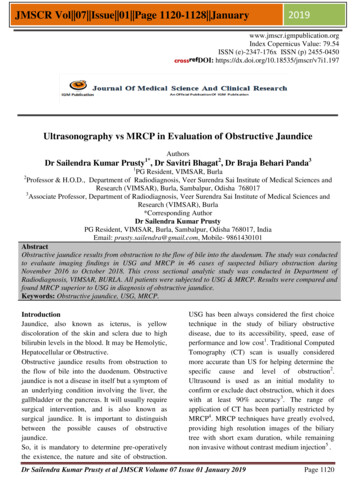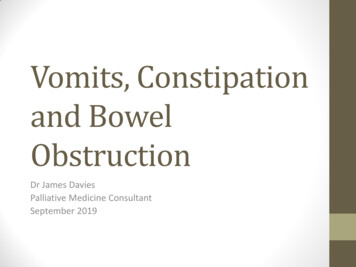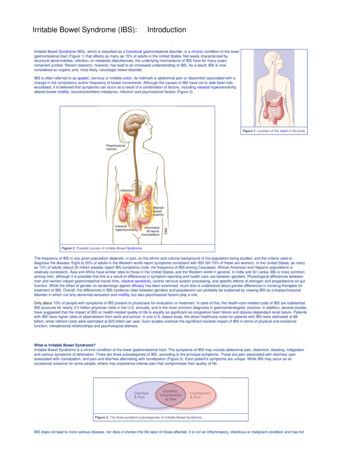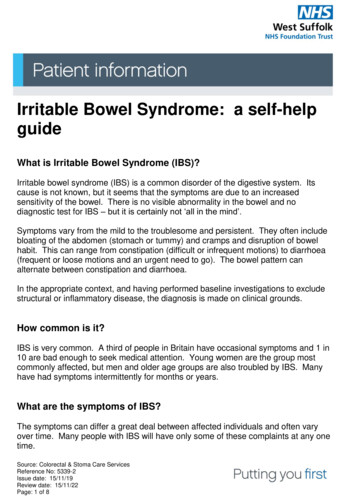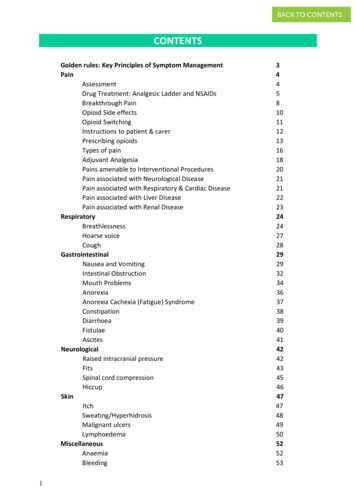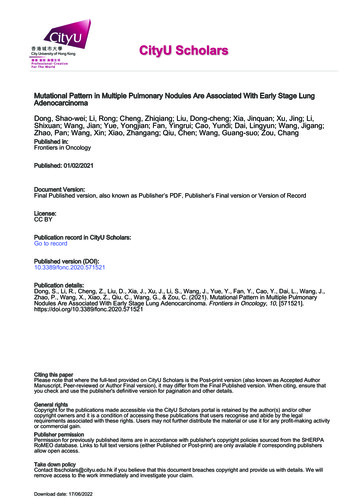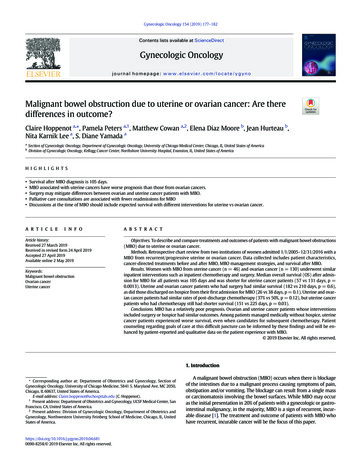
Transcription
Gynecologic Oncology 154 (2019) 177–182Contents lists available at ScienceDirectGynecologic Oncologyjournal homepage: www.elsevier.com/locate/ygynoMalignant bowel obstruction due to uterine or ovarian cancer: Are theredifferences in outcome?Claire Hoppenot a,⁎, Pamela Peters a,1, Matthew Cowan a,2, Elena Diaz Moore b, Jean Hurteau b,Nita Karnik Lee a, S. Diane Yamada aabSection of Gynecologic Oncology, Department of Gynecologic Oncology, University of Chicago Medical Center, Chicago, IL, United States of AmericaDivision of Gynecologic Oncology, Kellogg Cancer Center, Northshore University Hospital, Evanston, IL, United States of AmericaH I G H L I G H T S Survival after MBO diagnosis is 105 days.MBO associated with uterine cancers have worse prognosis than those from ovarian cancers.Surgery may mitigate differences between ovarian and uterine cancer patients with MBO.Palliative care consultations are associated with fewer readmissions for MBODiscussions at the time of MBO should include expected survival with different interventions for uterine vs ovarian cancer.a r t i c l ei n f oArticle history:Received 27 March 2019Received in revised form 24 April 2019Accepted 27 April 2019Available online 2 May 2019Keywords:Malignant bowel obstructionOvarian cancerUterine cancera b s t r a c tObjectives. To describe and compare treatments and outcomes of patients with malignant bowel obstructions(MBO) due to uterine or ovarian cancer.Methods. Retrospective chart review from two institutions of women admitted 1/1/2005–12/31/2016 with aMBO from recurrent/progressive uterine or ovarian cancer. Data collected includes patient characteristics,cancer-directed treatments before and after MBO, MBO management strategies, and survival after MBO.Results. Women with MBO from uterine cancer (n 46) and ovarian cancer (n 130) underwent similarinpatient interventions such as inpatient chemotherapy and surgery. Median overall survival (OS) after admission for MBO for all patients was 105 days and was shorter for uterine cancer patients (57 vs 131 days, p 0.0013). Uterine and ovarian cancer patients who had surgery had similar survival (182 vs 210 days, p 0.6),as did those discharged on hospice from their first admission for MBO (26 vs 38 days, p 0.1). Uterine and ovarian cancer patients had similar rates of post-discharge chemotherapy (37% vs 50%, p 0.12), but uterine cancerpatients who had chemotherapy still had shorter survival (151 vs 225 days, p 0.03).Conclusions. MBO has a relatively poor prognosis. Ovarian and uterine cancer patients whose interventionsincluded surgery or hospice had similar outcomes. Among patients managed medically without hospice, uterinecancer patients experienced worse survival, even when candidates for subsequent chemotherapy. Patientcounseling regarding goals of care at this difficult juncture can be informed by these findings and will be enhanced by patient-reported and qualitative data on the patient experience with MBO. 2019 Elsevier Inc. All rights reserved.1. Introduction⁎ Corresponding author at: Department of Obstetrics and Gynecology, Section ofGynecologic Oncology, University of Chicago Medicine, 5841 S. Maryland Ave, MC 2050,Chicago, IL 60637, United States of America.E-mail address: Claire.hoppenot@uchospitals.edu (C. Hoppenot).1Present address: Department of Obstetrics and Gynecology, UCSF Medical Center, SanFrancisco, CA, United States of America.2Present address: Division of Gynecologic Oncology, Department of Obstetrics andGynecology, Northwestern University Feinberg School of Medicine, Chicago, IL, UnitedStates of 10090-8258/ 2019 Elsevier Inc. All rights reserved.A malignant bowel obstruction (MBO) occurs when there is blockageof the intestines due to a malignant process causing symptoms of pain,obstipation and/or vomiting. The blockage can result from a single massor carcinomatosis involving the bowel surfaces. While MBO may occuras the initial presentation in 20% of patients with a gynecologic or gastrointestinal malignancy, in the majority, MBO is a sign of recurrent, incurable disease [1]. The treatment and outcome of patients with MBO whohave recurrent, incurable cancer will be the focus of this paper.
178C. Hoppenot et al. / Gynecologic Oncology 154 (2019) 177–182Among gynecologic cancers, MBO is most common in women withcancer of the ovaries, fallopian tube and peritoneum (subsequently referred to as “ovarian cancer”), and ultimately occurs in up to 20% of patients [2,3,4]. MBO has also been described as an end of life condition in3–11% of uterine cancer patients [1]. Treatments range from hospicecare to surgery with bowel resections and/or ostomy placement. However, all treatments remain palliative with a median life expectancyafter diagnosis of MBO ranging from 109 to 193 days with surgery,and 33 to 98 days without surgery [3,4,5,6].Counseling patients and their families on palliative treatments iscomplex, dependent on individual patient performance status, personalvalues and physician perspectives. In order to help patients make decisions that are congruent with their wishes in the context of the reality oftheir disease status, accurate outcome data is necessary. However, thereremain large gaps in the data about prognosis and treatment availablefor patients with ovarian cancer who develop MBO, and even less isknown in the setting of uterine cancer.We sought to describe the presentation, treatments and outcomes ofpatients with uterine cancer presenting with a MBO and compare themto those with ovarian cancer to provide data that can guide the difficultcounseling and decision-making process. We hypothesized that uterinecancer patients presenting with MBO would have poorer overall outcomes compared to their ovarian cancer counterparts.2. MethodsThis is a retrospective chart review of women with a MBO due to recurrent or persistent ovarian and uterine cancers admitted between 1/1/2005 and 6/30/2016 at two urban academic institutions. IRB approvalwas obtained at each site. The patient list was derived independently ateach institution. At the university hospital, the list was developedthrough two methods. First, an electronic search of radiology reportsfor attending gynecologic oncology physician names and any of theterms “obstruction,” “nausea,” “vomiting,” “pain,” or “bloating” was performed. A single investigator (CH) reviewed the reports to identify eligible patients. Then, the first three billed diagnoses for each patientadmitted to the hospital under the section of gynecologic oncologywere reviewed for key terms of nausea/vomiting or bowel obstruction(ICD9 codes 560 and ICD10 codes K56.0, K56.6, K56.69 and K56.7) andthe resulting list was reviewed for eligible patients. At theacademically-affiliated private hospital, an electronic data warehousewas utilized to perform a search for ICD-9 and -10 codes for ovarian,uterine and cervical cancers as well as for bowel obstruction to generatea list of potential patients.Two investigators (CH and PP) then manually reviewed the appropriate electronic medical records. Inclusion criteria included MBOfrom recurrent or progressive ovarian or uterine cancer of any histology,clinical and/or radiographic evidence of bowel obstruction, and admission to the hospital for management of bowel obstruction. Exclusioncriteria included bowel obstruction deemed to be from benign causesbased on surgery, pathology, or subsequent course or from a cancerother than ovarian or uterine cancer, outpatient management only,MBO at initial cancer diagnosis subsequently treated with curative intent, and emergent factors at presentation, such as bowel perforation,regardless of subsequent management.The investigators abstracted patient and disease characteristics aswell as information on hospital course for the first four MBO admissionsper patient. Between 2005 and 2012, data was available from the EMRin the form of discharge summaries, pathology reports and radiology reports. After 2012, additional information was available through dailyprogress and consult notes. All data was entered into an electronicdata management system (RedCap) and 10% of charts were spotchecked for accuracy by a single investigator (MC). Follow-up wastracked through outpatient, telephone, and readmission notes. Wheredates of death were not available in the medical record, obituary andsocial security databases were searched and patient date of deathconfirmed.The primary outcome of interest was survival after MBO. Exposuresof interest included operative and palliative care team involvement inmanagement for MBO. STATA 13 (StataCorps, 2013) was used for statistical analysis to compare variables associated with uterine cancer ascompared to ovarian cancer. Student's t-test was used for continuousvariables and chi-square for categorical variables. A multivariate analysis for survival was performed with a Cox regression model using theEfron method for ties.3. ResultsPatient selection is outlined in Fig. 1. At the university-based institution, over 2000 billed admissions and 1200 radiology reports were retrieved. After initial review of admission diagnoses and radiologyreports, 311 charts were reviewed and 86 patients identified as eligiblefor inclusion. At the academically-affiliated private institution, 215charts identified by the electronic data warehouse were reviewed andultimately 90 patients were found to be eligible, for a total of 130women with ovarian cancer and 46 women with uterine cancer.The characteristics of the patient population diagnosed with MBOare presented in Table 1. Overall, 62% of patients identified as whiteand 23% as black. The two institutions had different patient demographics; 43% of the patients at the university hospital identified aswhite and 37% as black, while at the academically-affiliated private hospital, 79% of the patients identified as white. Cancer histology, age attime of MBO, stage and practice patterns, including rates of surgerywere similar between the institutions (data not shown).At the time of diagnosis with MBO, uterine cancer patients wereolder than ovarian cancer patients and were more likely to identify asblack (Table 1). The majority of ovarian cancer patients had serous histology (82%) while the majority of uterine cancer patients had type 2endometrial cancer histologies (67%). Both groups presented with similar albumin levels and rates of associated ascites and carcinomatosis,but uterine cancer patients tended to have had fewer previous chemotherapy regimens with a shorter time to development of MBO from diagnosis (16.2 months vs 29.3 months). They were also more likely tohave been treated with radiation and to have had earlier stage cancersat original diagnosis than women with MBO from ovarian cancer.Patients with ovarian and uterine cancers received similar treatments for the management of MBO (Table 2). Forty-eight patients(27% of all patients) had an invasive procedure for MBO within thefirst 4 admissions; 58% of these at the first admission. Eleven of theseprocedures were laparotomies performed to place a venting G-tube;these patients were subsequently excluded from the “surgical patient”group, although the outcomes were similar regardless of the group inwhich these women were included. Compared to nonsurgical and Gtube patients, surgical patients (n 37) had similar median age, racedistribution, albumin at MBO diagnosis, time since cancer diagnosis,ovarian versus uterine origin, and active chemotherapy treatment at diagnosis of first MBO, but they were less likely to have known carcinomatosis (p 0.03) or ascites (p 0.01) (Supplementary Table 1). Overall,41 women (24%) received a venting G-tube, either minimallyinvasively placed (endoscopically or IR-guided) or through a laparotomy (Table 2). Chemotherapy was given during any admission in 24%of patients (n 41). Overall, N95% of patients admitted for MBO weretolerating some diet at discharge.Ovarian cancer patients had a higher overall number of admissionsand had a longer cumulative length of stay for their MBO management.Additionally, 54% of ovarian cancer patients as compared to 34% uterinecancer patients were readmitted for recurrent MBO. We also noted atrend towards fewer women with uterine cancer than ovarian cancer(p 0.12) having at least one form of outpatient treatment after MBOdiagnosis, whether chemotherapy, PARP inhibitors, or targetedtreatments.
C. Hoppenot et al. / Gynecologic Oncology 154 (2019) 177–1822082 billed admissions1253 imaging reportsBenign pathologyInitial cancer diagnosisNo inpatient imagingNo bowel obstruction311 charts reviewed withdocumented diagnosis ofmalignant bowelobstruction179215 patients withbowel obstruction andgynecologic cancerInconsistent symptomsNo admissionAdhesive obstructionBowel perforationCervical cancer86 patients:62 ovarian cancer24 uterine cancer90 patients:68 ovarian cancer22 uterine cancerFig. 1. Diagram outlining patient selection at each institution.Palliative care was involved at first admission for MBO for 30% ofwomen with either ovarian or uterine cancer. Yet uterine cancer patients were more likely to be discharged to hospice from their first admission for MBO (17 uterine patients (37%) vs 22 ovarian patients(17%), p 0.005). Patients who had a palliative care consultation during the first admission were less likely to experience a second admissioncompared to those who did not have an initial palliative careTable 1Demographics.Ovarian (n 130)aAgeRace: : SerousOtherUterus: Serous/clear cellCarcinosarcomaEndometrioidSarcomaNo previous chemo regimensStage III/IVPrevious radiationTime from cancer diagnosis to initial MBO(months)Albumin at MBObAscites at MBOcCarcinomatosis at MBO63 (41–83)Uterine (n 46)a89 (70%)20 (15%)67(47–83)20 (43%)17 (37%)5 (4%)9 (7%)8 (6%)2 (4%)3 (7%)4 (9%)p-Valuep 0.013 (1–7)123 (95%)36 (78%)8 (6%)24 (52%)29.3(3.7–123)3.4(2.2–4.4)67 (52%)58 (45%)16.2(7.4–97)3.2(1.7–4.5)22 (51%)21 (46%)Table 2Interventions.p 0.005106 (82%)24 (18%)17 (37%)10 (22%)15 (33%)4 (8%)2 (1–5)consultation (11/55 (20%) vs 75/126 (59%), p b 0.0001), even after excluding 45 patients discharged on hospice or deceased after first admission (9/25 (36%) vs 75/109 (69%), p 0.002). There was a trendtowards a lower rate of outpatient TPN use as well (7% vs 18%, p 0.05). Surgical patients had lower rates of palliative care consultation(11% versus 35%, p 0.004) and a higher rate of readmission (64% versus 45%, p 0.03). When excluding 43 nonsurgical and 2 surgical patients discharged on hospice or deceased after their first MBOadmission, however, readmission rates were similar between surgicaland nonsurgical groups (71% vs 62%, p 0.4).p 0.006p 0.0001pb0.0001p 0.04p 0.11p 0.34p 0.9p-values b 0.05 are presented in bold.aUnless otherwise noted, reported as median (95% confidence interval) or number(percentage).bAvailable for 170 patients.cAvailable for 168 patients.Inpatient chemotherapySurgery (laparotomy)aBowel resectionOstomyLysis of adhesions onlyGastrostomy tube (G-tube)Via laparotomybMinimally-invasive GTcUnsuccessful attempt at G-tubeColonic stentInpatient TPNDischarge TPNAt least one readmissionTotal # of admissionsTotal inpatient days for MBO acrossadmissionsOvarian (n 130)Uterine (n 46)p-Value31 (24%)29 (22%)2113610 (22%)8 (17%)341p 0.8p 0.511 (8%)23 (18%)7 (5.3%)6 (4.5%)44 (34%)23 (17%)70 (54%)2 (1–5)14 (4–50)1 (2%)6 (12%)4 (8%)2 (4.3%)10 (22%)4 (8.7%)16 (34%)1 (1–4)10.5 (3–42)p 0.1p 0.5p 0.7p 0.11p 0.12p 0.03p 0.02p 0.047*Unless otherwise noted, reported as median (95% CI) or number (percentage).p-values b 0.05 are presented in bold.aOvarian cancer patients who underwent surgery had more than one procedure. Patients who had an invasive procedure for G-tube placement were excluded.bThese patients were excluded from the “surgical” group. G-tube placement duringlaparotomy was not always the initial intention of the laparotomy. Only 1 patient had afailed minimally-invasive attempt at GT placement prior to laparotomy for a G-tube. 2 patients had a concurrent bowel resection, and 1 patient had a concurrent ostomy.cEndoscopic or interventional radiology placement of gastrostomy tube as opposed tosurgically placed gastrostomy tube. One patient had both a laparotomy GT followed by aminimally-invasive GT and was put in the laparotomy GT group.
180C. Hoppenot et al. / Gynecologic Oncology 154 (2019) 177–182Of note, as practice patterns changed over the time period includedin this study, the rate of palliative care consults during first admissiondramatically increased over time, from 7.7% before 2012 to 40% after2012 (p b 0.0001). Other interventions, such as rates of surgery andTPN, remained stable, however, the rate of inpatient chemotherapydropped from 35% before 2012 to 20% after 2012 (p 0.02).Mortality within 30 days of first admission was 22% (39 patients)and another 14% (19 patients) died within 30 days of a subsequent discharge for MBO. Median overall survival after initial diagnosis of MBOfor the total group was 105 days, but significantly shorter for womenwith uterine cancer as compared to those with ovarian cancer (57days vs 131 days, p 0.003) (Table 3).Eight 8 (17%) uterine cancer patients and 29 (22%) ovarian cancerpatients had a surgical intervention for MBO, excluding patients whohad procedures only for venting G-tube placement (Table 2). Therewas no difference in median survival by primary cancer type when surgery was performed (182 days vs 210 days, p 0.6). Among patientswho did not have surgery, uterine cancer patients experienced significantly shorter survival (median 46 vs 110 days, p 0.001) (Table 3).After excluding patients discharged on hospice, a similar proportionof uterine and ovarian cancer patients had subsequent treatment (60%vs 58%); among these patients, those with uterine cancer had shortersurvival (151 days vs 225 days, p 0.03) (Table 3). Median survivalwas similar in subgroups of uterine and ovarian cancer patients whohad surgery followed by outpatient chemotherapy (182 days vs 314days, p 0.18).Univariate analyses showed that survival was associated with younger age, white versus black race, higher albumin, longer time since diagnosis, absence of ascites, previous platinum sensitivity, undergoingsurgery, outpatient chemotherapy after discharge from MBO admission,administration of TPN, and ovarian versus uterine origin of cancer. Amultivariate analysis to control for factors that differed between ovarianand uterine cancer patients and other factors associated with survivalwas performed (Table 4). It showed that uterine cancer origin (as wellas age, race, ability to undergo surgery, receiving chemotherapy afterMBO, and initial albumin) were independently associated with survivalafter MBO.4. DiscussionOur study supports previous evidence that a diagnosis of MBO fromrecurrent/progressive gynecologic cancer is an end-of-life state [3,4,5,6],with overall median survival of 105 days. Women with uterine cancer inour cohort had a median survival after MBO diagnosis that was less thanhalf that of their ovarian cancer counterparts (57 days vs 131 days) despite the fact that a smaller percentage presented with advanced stagedisease and they had fewer previous chemotherapy regimens. Thepoor prognosis of women with uterine cancer who present with MBOTable 4Multivariate analysis for survival after MBO.aAge (continuous)Albumin (continuous)Race – black (compared to white)Patients who underwent surgerybUterine origin (compared to ovarian)Chemotherapy after MBOAscitesTime from diagnosis to MBOabHazard ratiop-Value95% 110.35 - 9 patients included.Invasive procedures, excluding patients who had procedures for G-tubes.corroborates the findings in other small studies and supports our original hypothesis [7].The novel finding in our study is that for those uterine cancer patients who do undergo surgery, the survival outcome approaches thatof ovarian cancer patients (182 days vs 210 days). A similar percentageof patients (37–50%) are able to undergo chemotherapy after MBO butthe overall impact on survival is limited with a median 2 -month shortersurvival in uterine cancer patients undergoing chemotherapy comparedto ovarian cancer patients. The relative resistance of recurrent uterinecancer to subsequent therapy and the lack of effective, sequential therapies in uterine cancer is well known [8,9]. Even in the adjuvant setting,a case-control study of advanced stage uterine and ovarian cancersmatched for age and residual disease after cytoreduction showedshorter survival in the uterine cancer patients, including optimallydebulked patients [10]. Their findings suggest a difference in tumor biology between the two types of cancer despite a similar disease spreadpattern and presentation.The question of which uterine cancer patients are better suited forsurgical intervention of MBO is a difficult one that this study cannotfully address. For both uterine and ovarian cancer patients, womenwho had surgery had longer survival than those treated medically(182 vs 46 days for uterine cancer patients, 210 vs 110 days for ovariancancer patients). However, these patients did exclude those who werefound to have such extensive disease at laparotomy that they were palliated with a G-tube. In our study, surgical patients had less carcinomatosis and less ascites than nonsurgical patients, but had similardemographic factors such as age, albumin, and treatment status. It islikely that these are patients that had more limited disease and therefore already had a more favorable prognosis. Other studies have foundthat survival after MBO is inversely correlated with independent factorsassociated with poor prognosis, such as older age, non-ovarian primary,ascites, carcinomatosis, hypoalbuminemia, and leukocytosis regardlessof surgical intervention [6,11].Recent large database studies have found conflicting results regarding the benefits of surgery for MBO. A study of patients with MBO fromTable 3Outcomes.Chemo after discharge from first MBO admissionExcluding hospice patients (n 108)Survival after MBO (days)With chemo after first MBO admission (n 82)With surgerya for MBO (n 37)Without surgery for MBO (n 139)Without surgery or chemo (n 77)Discharged on hospice from 1st admission (n 41)30-day mortality from MBO diagnosisOverall survival (months)Discharge to hospice from 1st MBO admissionOvarian (n 130)Uterine (n 46)65 (50%)65 (60%)131 (13–1026)225 (58–1135)210 (26–1368)110 (11–661)55 (6–758)38 (12–237)16 (12%)37 (9.1–123)22 (17%)17 (37%)17 (58%)57 (6–623)151 (42–652)182 (28–1341)46 (6–555)25 (4–513)26 (3–554)15 (32%)21 (8.9–110)17 (37%)*Unless otherwise noted, reported as median (95% CI) or number (percentage).p-values b 0.05 are presented in bold.aInvasive procedures, excluding patients who had the procedure for placement of a G-tube.p-Valuep 0.12p 0.0013p 0.03p 0.6p 0.001p 0.01p 0.10p 0.002p 0.003p 0.005
C. Hoppenot et al. / Gynecologic Oncology 154 (2019) 177–182ovarian or pancreatic cancer in the SEER database found longer mediansurvival in surgically-managed patients compared to those managedmedically or with a G-tube (128 days versus 72 days versus 38 days, respectively) with similar in-hospital mortality and lower readmissions[3]. In contrast, a database study of patients with MBO from any cancerrevealed a lower number of hospital-free days and no improvement insurvival for those patients who underwent surgery compared to theirmedically managed counterparts [12]. However, in contrast to ourstudy, these studies did not exclude patients who had emergent surgeries due to MBO and were not limited to gynecologic cancer patients. Thedifferences we found in outcomes with different gynecologic cancerssuggests that MBO from different cancers may require individualizedapproaches. The effect of surgery itself for MBO is being studied in a prospective trial, SWOG S1316. However, to be part of the study, patientswith MBO must already be considered surgical candidates, which maybias results and limit generalizability. Our results do provide data onsurvival after individual interventions that can aid clinicians who areat a crossroads in making treatment recommendations specific to uterine and ovarian cancer patients.With such a short median survival, using MBO as a trigger for involvement of palliative care, documenting goals of care, and sharingprognosis is appropriate. Unfortunately, we could not collect information on patient-reported outcomes of symptom-free time due to limitations of a chart review. We did find lower readmission rates in womenwith an inpatient palliative care consultation, which could be due to improved symptom control, better social support or outpatient follow-up.It may also reflect patient and physician directed self-selection of palliative care consultation when less aggressive therapies are better in linewith a patient's goals towards the end of life. This is supported by theparticularly low rate of surgery and a trend towards lower outpatientTPN use in patients who had palliative care consultations.From the patient perspective, studies with patient-centered objectives can provide information that is meaningful to patients as they delineate their treatment goals and make end of life choices. This will needto include information not just about length of survival, but quality oflife with each intervention. Patients with advanced-stage ovarian cancerhave been shown to be willing to trade months of progression-free survival for a less emetogenic chemotherapy regimen or a reduction in abdominal symptoms [13]; patients with MBO are also likely to havepriorities to balance against solely length of survival. Societal, family,and personal cost of each option also requires further study. Many ofthese factors cannot be extracted from charts and will require attentionto quantitative patient-reported outcomes and qualitative patientcentered research.Additionally, a concerning factor associated with decreased survivalin our study is black race. The literature has mixed findings on racial disparities in outcomes for black women with gynecologic cancers[14,15,16,17], and the question of causes of disparities requires furtherstudy.This study is subject to potential confounders inherent in retrospective reviews, where patient identification and treatment course may bebiased by factors not available in the documentation. We have acquireda breadth of data to attempt to control for confounders such as previoustreatments, disease status, and patient characteristics such as age andrace, but cannot control for personal and institutional factors missingfrom the charts. While patient lists were acquired by different methodsreadily available at each hospital, we assumed that the patient datasetidentified through billing diagnoses and the data warehouse would besimilar. In addition, we were not able to collect information, includingpatient reported information on quality of life and symptoms, or detailed information on physician thought process and biases around recommendations that might influence care.This study's strengths, however, include a thorough manual chart review with accuracy confirmed by a second reviewer for at least 10% ofthe charts, which allowed us to collect specific data points not availablein large database studies such as the specific timing of different181interventions throughout the admissions and documentation of conversations. The multi-institutional nature of this study with diverse patientpopulation also helps to increase generalizability.5. ConclusionSurvival after MBO from recurrent or progressive ovarian or uterinecancer remains short, with a median survival of 105 days. Based on ourfindings, patients with MBO from uterine cancer can be counseled thattheir overall survival after an initial MBO diagnosis, when managedmedically, is shorter than for those with ovarian cancer, even ifreceiving chemotherapy afterward. Survival for uterine cancer patientswho undergo surgery after MBO is similar to their ovarian cancercounterparts.Supplementary data to this article can be found online at https://doi.org/10.1016/j.ygyno.2019.04.681.COI statementThe authors report no conflicts of interest in relation to the information relayed in this manuscript.Author contributionSDY and CH contributed to the study design. CH, PP, MC, and EMcontributed to the data collection. SDY, NL, JH, and EM provided patientsfor the study. CH, PP, MC, EM, NL, JH and SDY contributed to the manuscript preparation.References[1] A. Tuca, E. Guell, E. Martinez-Losada, N. Codorniu, Malignant bowel obstruction inadvanced cancer patients: epidemiology, management, and factors influencingspontaneous resolution, Cancer Manag. Res. 4 (2012) 159–169.[2] P.M. Dvoretsky, K.A. Richards, C. Angel, L. Rabinowitz, J.B. Beecham, T.A. Bonfiglio,Survival time, causes of death, and tumor/treatment-related morbidity in 100women with ovarian cancer, Hum. Pathol. 19 (1988) 1273–1279.[3] E.J. Lilley, J.W. Scott, J.E. Goldberg, C.E. Cauley, J.S. Temel, A.S. Epstein, et al., Survival,healthcare utilization, and end-of-life care among older adults with malignancyassociated bowel obstruction: comparative study of surgery, venting gastrostomy,or medical management, Ann. Surg. 267 (4) (2018) 692–699.[4] S.J. Mooney, M. Winner, D.L. Hershman, J.D. Wright, D.L. Feingold, J.D. Allendorf,et al., Bowel obstruction in elderly ovarian cancer patients: a population-basedstudy, Gynecol. Oncol. 129 (2013) 107–112.[5] J. Terrah, C.P. Paul Olson, Karen J. Brasel, Margaret L. Schwarze, Palliative surgery formalignant bowel obstruction from carcinomatosis, a systematic review, JAMA. 149(2014) 383–392.[6] T. Perri, J. Korach, G. Ben-Baruch, A. Jako
a Section of Gynecologic Oncology, Department of Gynecologic Oncology, University of Chicago Medical Center, Chicago, IL, United States of America b Division of Gynecologic Oncology, Kellogg Cancer Center, Northshore University Hospital, Evanston, IL, United States of America HIGHLIGHTS Survival after MBO diagnosis is 105 days.

